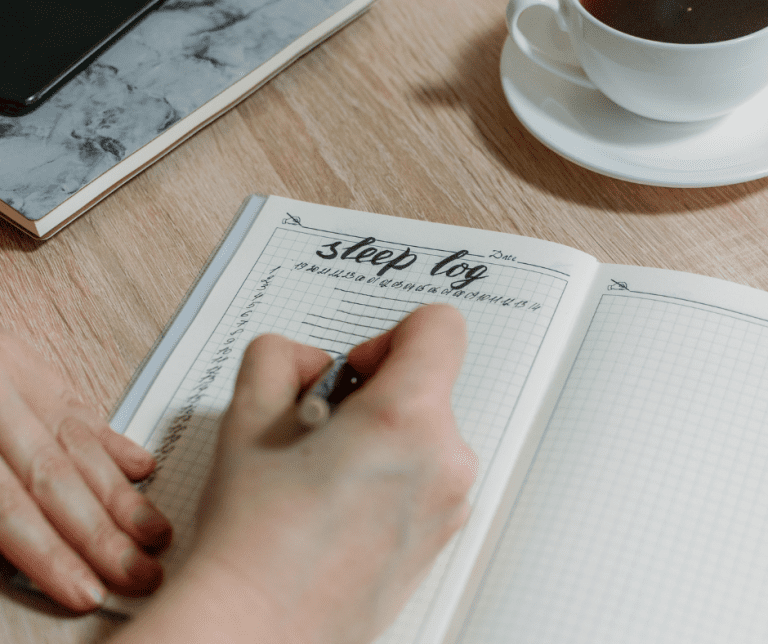
Do you often find yourself waking up groggy and tired without any explanation? Keeping a sleep diary might be the key to unlocking the mysteries of your sleep patterns. A sleep diary, also known as a ‘sleep journal’ or ‘sleep log’, is a simple yet effective way to track your sleep habits, identify potential issues and make necessary adjustments for better sleep quality. In this article, we will provide practical tips on getting started and maintaining consistency in sleep journaling. So, if you’re ready to take control of your sleep and wake up feeling refreshed, let’s dive into the fascinating world of sleep tracking!
What is a Sleep Diary?
A sleep diary is a simple yet powerful tool that allows you to track and log various aspects of your sleep patterns and habits. It acts as a personal sleep journal where you can document essential details, such as your bedtime, sleep latency, sleep duration, any disturbances during the night and your overall sleep quality.
Below are some of the advantages of keeping a sleep diary:
- Provides insight into your sleep patterns and habits
- Helps identify potential sleep disruptions or issues
- Allows for tracking of sleep quality and duration
- Helps establish a consistent sleep routine
- Provides data to identify patterns or trends affecting sleep
- Enables you to make informed adjustments to enhance sleep hygiene
- Acts as a tool to monitor the effectiveness of sleep interventions or changes
- Facilitates communication with healthcare professionals about sleep concerns
- Helps identify external factors that may impact sleep, such as stress or environment
- Allows you to take control of your sleep and make informed decisions for better rest
How to Keep a Sleep Diary
Now that you have a better idea of what a sleep diary is and how it can benefit you, we’ll walk you through some practical tips on starting and keeping a sleep diary effectively.
#1 Choose a format
When it comes to keeping a sleep journal, one of the first decisions you’ll need to make is selecting the proper format. You have options like traditional pen-and-paper diaries or digital alternatives such as spreadsheets or sleep-tracking apps. The pen-and-paper approach offers a personal touch and easy reflection, while digital tools provide automatic tracking and comprehensive reports and visualisations of your sleep data. The key to choosing the right format is to consider your personal preferences, what you think will work best for you and what will motivate you to record your sleep data consistently.
#2 Create your sleep log template
A crucial step in keeping a sleep diary is creating a well-designed sleep log template. This template will serve as the framework for recording your sleep-related information accurately and efficiently. By personalising your sleep log to suit your specific needs, you can capture essential details and easily track patterns over time.
To create your template, start by deciding what information you want to include in your sleep log. According to Sleep Foundation, some common elements to consider are the following:
- Bedtime
- Wake-up time
- Sleep latency (or the time it takes you to fall asleep)
- Frequency and duration of sleep disturbances
- Frequency and duration of daytime naps
- Personal rating of sleep quality
- Alcoholic and caffeinated beverages and/or tobacco
- Medications used
- Exercise
- Stress levels
Alternatively, you may also opt for ready-to-use templates created by trusted health organisations like NHLBI’s (National Heart, Lung and Blood Institute) sleep diary template.
In some cases, it is possible that your sleep specialist may offer you a specially designed sleep log template that they commonly use with their patients.
#3 Maintain your diary for at least 1 to 2 weeks
Experts suggest keeping your sleep diary for a minimum of 1 to 2 weeks to obtain meaningful insights into your sleep patterns. Consistently tracking your sleep habits over this time frame enhances the reliability of your sleep data, allowing you to make more accurate assessments, observations and improvements.
#4 Make your diary a part of your routine
Setting aside time to fill out your sleep diary is a crucial step in ensuring its effectiveness. By allocating dedicated moments regularly, you create a routine that fosters consistency and accuracy in documenting your sleep-related information. For example, before bed, take a few minutes to note details such as your bedtime, any notable factors impacting your sleep and your expectations for the upcoming night. In the morning, take a moment to record your wake-up time, sleep quality and any observations or reflections on your sleep experience. Consistently prioritising these moments will help you establish a routine that ensures accurate and comprehensive data in your sleep diary.
Taking Control of Your Sleep Health with a Sleep Diary
In conclusion, a sleep diary is a valuable tool for improving sleep and overall well-being. By diligently tracking your sleep patterns and habits, you gain valuable insights that can guide you towards making positive changes. From identifying potential sleep disruptions to establishing a consistent sleep routine, a sleep diary helps you take control of your sleep health. Committing to a sleep diary requires discipline, but the benefits of better sleep and improved quality of life make it well worth the effort. So start your sleep diary today and unlock the secrets to a restful and rejuvenating sleep!
As you track your sleep with a diary, you may realise the importance of your sleep environment. If you want to improve your sleep experience, explore the full range of Sealy mattresses or take our mattress selector quiz for a personalised recommendation.





